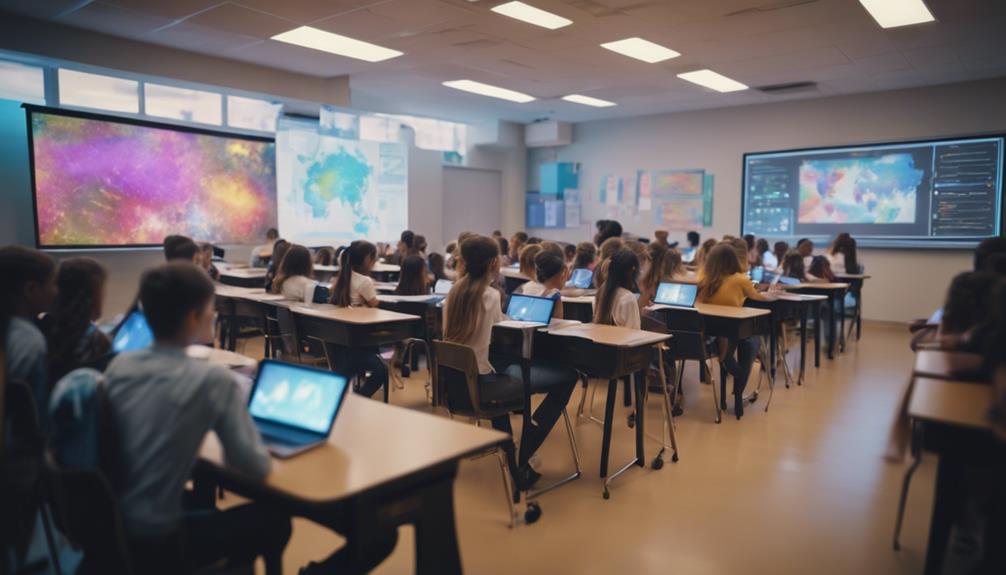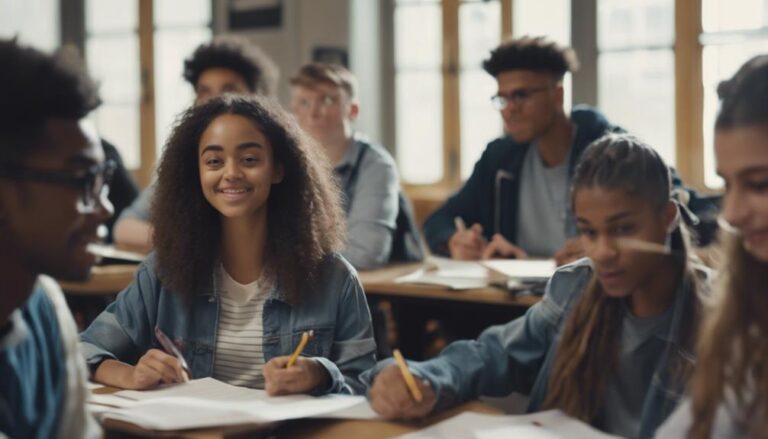Enhancing Learning With Visual Aids and Multimedia Resources
Immerse yourself in interactive visuals and multimedia resources to enhance learning, understand better, and engage in new, exciting ways. Embrace visual storytelling to grasp complex ideas easily. Experience immersive learning through virtual reality. Use diagrams, charts, and infographics for streamlined information. Collaborate with online tools for creativity. Utilise colour-coding for improved understanding. Enhance comprehension with interactive diagrams and engaging infographics. Revolutionise learning processes with visual aids. Incorporate multimedia for hands-on experiences. Visual communication energises traditional teaching methods, captivating students. Use engaging multimedia to harness dynamic visual techniques. Open a world of innovative learning approaches through visual aids and multimedia resources.
Visual Learning Techniques
To maximise your learning potential, immerse yourself in the domain of visual learning techniques where creativity and technology merge to revolutionise how you absorb and retain information. Visual storytelling captivates your imagination, making complex concepts more accessible. Interactive simulations take you on a journey of discovery, engaging both your intellect and emotions.
Dive into the world of virtual reality, where interactive quizzes turn studying into an exciting adventure. These immersive experiences not only test your knowledge but also enhance your understanding through hands-on learning. Embrace the power of diagrams, charts, and graphs to organise information effectively, revealing new pathways to comprehension. Online presentation tools and virtual whiteboards offer dynamic platforms for visual learning engagement, fostering collaboration and creativity.
Visual Learning Strategies
Maximise the potential of your visual learning journey by incorporating cutting-edge strategies that utilise the power of diagrams, charts, and interactive tools. Interactive diagrams and virtual reality experiences can immerse you in the subject matter, making complex concepts easier to grasp. Infographics and data visualisation tools offer a creative way to represent information visually, aiding in better retention and understanding.
| Visual Learning Strategies | Description | Benefits |
|---|---|---|
| Interactive Diagrams | Engage with dynamic content for hands-on learning. | Enhances interactivity and engagement. |
| Virtual Reality | Explore subjects in a simulated environment. | Provides an immersive learning experience. |
| Infographics | Simplify complex data through visual representation. | Facilitates quick comprehension. |
| Data Visualisation | Present information in a visually appealing manner. | Enhances data analysis skills. |
Incorporating these strategies into your learning process can revolutionise the way you absorb information, making your educational journey more interactive and enjoyable.
Visual Learning Methods
Enhance your learning experience by immersing yourself in innovative visual learning methods that leverage images, diagrams, charts, and videos to boost comprehension and retention. Incorporating interactive visuals and virtual reality can take your understanding to a whole new level. Infographics, interactive animations, and other dynamic visual aids offer engaging ways to grasp complex concepts. By organising information with visual cues such as colour-coding and highlighting, you can enhance both recall and understanding.
Engage with interactive visuals and virtual reality tools for a vital learning experience.
Explore the power of infographics and interactive animations to simplify intricate ideas.
Utilise mind mapping and online resources to foster creativity and critical thinking in your educational journey.
These methods aren't just beneficial in traditional learning environments; they're also essential in specialised fields like medical education and business training. So, immerse yourself in these innovative visual learning techniques to enhance your learning journey and acquire new skills effectively.
Improving Learning With Visual Aids
Incorporating cutting-edge visual aids revolutionises the learning process, propelling comprehension and retention to new heights.
Interactive presentations and engaging animations capture attention, making learning dynamic and exciting.
Creative infographics transform complex information into visually appealing formats, aiding in better understanding and memory retention.
Dynamic videos bring concepts to life, immersing students in a virtual learning experience that enhances engagement and critical thinking skills.
Effective Visual Learning Techniques
Using cutting-edge visual learning techniques can significantly improve understanding and information organisation, leading to a more interactive and efficient learning experience. To get the most out of these techniques, consider the following:
- Interactive Diagrams: Interactive diagrams allow you to delve into complex concepts by directly interacting with the content. This hands-on approach improves comprehension and recall.
- Engaging Infographics: Infographics present information in an attractive visual format, making it easier to grasp complex data. They blend images, charts, and text to effectively communicate key points.
- Colour-Coding Techniques: Utilising colours to emphasise important information helps in efficiently organising and remembering details. Colour-coded notes or visuals can assist in categorising and linking ideas seamlessly.
Visual Learning Tools
Hey, you're about to reveal the power of visual learning tools – the game-changers in education.
Let's explore why visuals matter, the different types of aids available, and how seamlessly integrating multimedia enhances your learning experience.
Get ready to access a world of knowledge through innovative visual aids!
Importance of Visuals
Visual aids revolutionise the learning experience by greatly enhancing memory retention and accelerating comprehension, making them indispensable tools in modern education. When it comes to the importance of visuals, consider these key facts:
- Visual aids improve memory retention by up to 65% compared to text-only learning.
- 90% of information transmitted to the brain is visual, highlighting the significance of visual aids in learning.
- Visual learning tools boost student engagement and motivation in the educational process.
With the ability to convey complex information through visual storytelling and engage learners through interactive presentations, visuals play a vital role in improving comprehension and retention rates, ultimately enhancing the overall learning experience.
Types of Visual Aids
Using state-of-the-art technology and creative design, contemporary visual learning tools include a wide range of interactive resources that transform traditional educational practices.
Interactive whiteboards and 3D models provide exciting ways to involve learners, enabling hands-on exploration and collaborative learning experiences.
Virtual reality and augmented reality elevate visual aids to a new level, plunging students into virtual worlds and improving their grasp of complex ideas. These tools not only accommodate different learning styles but also significantly enhance student engagement and memory.
By integrating interactive visual aids like mind mapping and digital storytelling, educators can establish an engaging learning environment that promotes profound comprehension and knowledge retention.
Embrace these innovative tools to change the educational scene and empower learners with a more enriching educational experience.
Effective Multimedia Integration
Incorporating state-of-the-art multimedia tools into educational practices enhances student engagement and knowledge retention significantly. When it comes to effective multimedia integration, consider the following:
- Interactive Engagement: Tools like Padlet, digital whiteboards, and OneNote offer interactive learning experiences that engage students effectively.
- Technology Integration: Platforms such as Sway and immersive technologies not only improve student engagement but also boost knowledge retention.
- Multimedia Benefits: Using multimedia resources like videos and audio feedback for active processing strategies helps students achieve a better understanding of complex concepts.
Multimedia in Education
Immersive multimedia technologies revolutionise the educational landscape by weaving together text, images, video, and audio to create dynamic learning environments. By integrating interactive simulations, engaging infographics, virtual reality experiences, and interactive whiteboards, multimedia in education enhances understanding and retention of complex concepts. Research indicates that this approach increases positive emotions in learners, leading to improved educational outcomes. Multimedia resources also provide access to diverse online content, enriching the overall learning experience. In addition, immersive learning opportunities with artificial intelligence offer personalised paths and real-time feedback for students, further enhancing the educational journey. To illustrate the impact of multimedia in education, consider the following table:
| Multimedia Element | Benefits |
|---|---|
| Interactive Simulations | Facilitates hands-on learning experiences |
| Engaging Infographics | Simplifies complex information visually |
| Virtual Reality Experiences | Enhances experiential learning |
| Interactive Whiteboards | Fosters collaborative learning |
| Artificial Intelligence | Provides personalised feedback and paths |
AV Technology in Schools
AV technology in schools transforms traditional learning spaces into dynamic, interactive hubs that foster engagement and visual comprehension among students. Schools invest in interactive displays, student engagement through tools like interactive whiteboards and projectors. Audio systems play a pivotal role in creating immersive learning experiences, enhancing information retention.
Virtual classrooms connect students globally, promoting collaboration and cultural exchange. These technologies align with modern educational trends, emphasising multimedia resources for effective learning outcomes. Integration of AV technology leads to improved classroom engagement and collaboration, creating interactive learning environments that cater to diverse learning styles.
Visual Communication in Teaching
Hey, educator! Let's discuss the importance of visual communication in education.
Importance of Visuals
Visual aids in teaching revolutionise traditional educational methods by enhancing student engagement and comprehension through dynamic visual communication techniques. When incorporating visuals in your lessons, you create an immersive learning experience that caters to diverse learning styles and fosters a deeper understanding of complex topics.
Here are some key points to note about the importance of visuals:
- Visual storytelling captures attention and simplifies abstract concepts.
- Interactive presentations promote active participation and knowledge retention.
- Visual aids stimulate critical thinking and creativity, leading to a more interactive and engaging learning environment.
Captivating Multimedia Content
Revolutionising traditional educational methods, engaging multimedia content in teaching harnesses dynamic visual communication techniques to enhance student learning experiences. By incorporating interactive engagement on multimedia platforms, educators can captivate learners through dynamic content and visual storytelling.
This approach goes beyond static images and text, offering a rich tapestry of videos, graphics, and animations to make learning more engaging and memorable. Visual aids like infographics and diagrams serve as powerful tools to simplify complex concepts, facilitating better understanding.
Through the integration of multimedia resources, students are encouraged to actively participate in their learning journey, leading to improved comprehension and knowledge retention. Embracing interactive learning tools in visual communication paves the way for a more immersive and effective educational experience.
Improving Student Comprehension
Transforming traditional educational approaches, the integration of visual communication in teaching elevates student understanding exponentially. Visual aids play a vital role in enhancing student comprehension. Here's why:
- Interactive presentations: Encouraging active participation and real-time feedback.
- Engaging videos: Captivating visual storytelling that simplifies complex topics.
- Immersive simulations, educational animations: Creating interactive environments for hands-on learning experiences.

Benjamin Margate is a British biology author, educator and podcaster, leveraging a leveraging a BSc in Biological Sciences from University of Birmingham and over 10 years of expertise creating and curating detailed biology content. His work focuses on providing educational blogs and resources for biology students and facilitating connections with professional tutors. Recognised for his extensive knowledge and commitment to biology education, Benjamin’s contributions have become a cornerstone for learners seeking to enhance their understanding of the subject.






